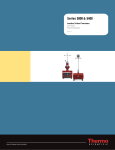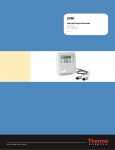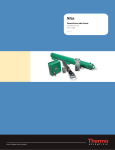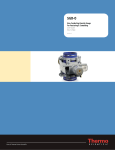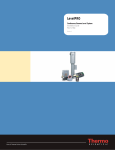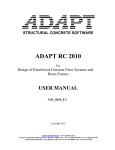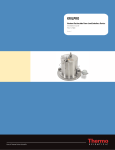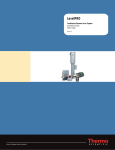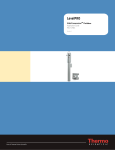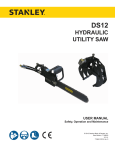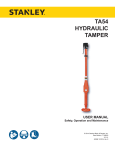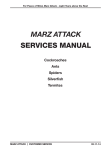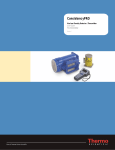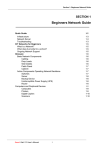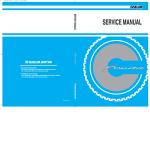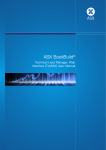Download Series 6500 & 6600 - User Manual
Transcript
Series 6500 & 6600 Inline Turbine Flowmeters User Guide P/N 057-0352-002 Revision C Part of Thermo Fisher Scientific Series 6500 & 6600 Inline Turbine Flowmeters User Guide P/N 057-0352-002 Revision C ©2011 Thermo Fisher Scientific Inc. All rights reserved. All trademarks are the property of Thermo Fisher Scientific Inc. and its subsidiaries. Disclaimer: Thermo Fisher Scientific (Thermo Fisher) makes every effort to ensure the accuracy and completeness of this guide. However, we cannot be responsible for errors, omissions, or any loss of data resulting from errors or omissions. Thermo Fisher reserves the right to make changes to the guide or improvement to the product at any time without notice. The material in this guide is proprietary and cannot be reproduced in any form without expressed written consent from Thermo Fisher. Process Instruments 14 Gormley Industrial Avenue Gormley, Ontario L0H 1G0 CANADA Unit 702-715, 7/F Tower West Yonghe Plaza No. 28 Andingmen East Street, Beijing 100007 CHINA +1 (800) 437-7979 +1 (713) 272-0404 direct +1 (713) 4573 fax +1 (905) 888-8808 +1 (905) 888-8828 fax +86 (10) 8419-3588 +86 (10) 8419-3580 fax A-101, 1CC Trade Tower Senapati Bapat Road Pune 411 016 Maharashtra, INDIA Ion Path, Road Three Winsford, Cheshire CW7 3GA UNITED KINGDOM 1410 Gillingham Lane Sugar Land, TX 77478 USA +91 (20) 6626 7000 +91 (20) 6626 7001 fax www.thermoscientific.com +44 (0) 1606 548700 +44 (0) 1606 548711 fax This page intentionally left blank. Series 6500 & 6600 Inline Turbine Flowmeters INLINE TURBINE FLOWMETERS SERIES 6500 & 6600 HANDBOOK Rev. C Revision History Issue Description 0 CN 8653 A Per ERO 4690 B Per ECO 5978 C Per ECO 7662 Thermo Fisher Scientific Series 6500 & 6600 Inline Turbine Flowmeters This page is blank Thermo Fisher Scientific Series 6500 & 6600 Inline Turbine Flowmeters SAFETY NOTICE Read this manual before working with the product. For personal and system safety, and optimum product performance, make sure you thoroughly understand the contents before installing, using or maintaining this product. YOU ARE RESPONSIBLE FOR YOUR OWN SAFETY AND THAT OF YOUR COLLEAGUES. Be aware of the weight of meters and the component parts as meters increase in size. Safety boots/shoes and eye protection must be worn whenever bench work is undertaken. Use lifting gear as appropriate, or, at certain assembly or disassembly stages, enlist extra help. Note: some items have sharp edges and corners. For equipment Thermo Fisher. service, please contact Thermo Scientific products satisfy all obligations arising from European Union legislation to harmonise product standards. Thermo Fisher Scientific Series 6500 & 6600 Inline Turbine Flowmeters This page is blank Thermo Fisher Scientific Series 6500 & 6600 Inline Turbine Flowmeters SECTION 1 INTRODUCTION INDEX Purpose Applicability Other Sources of Information Page No. 1-1 1-1 1-2 Control of Substances Hazardous to Health Pressure Hazards Electrical Safety Meter Protection Handling Pick-ups Installed Protection 2-1 2-1 2-1 2-2 2-1 2-2 2-2 SECTION 2 SAFETY SECTION 3 GENERAL DESCRIPTION Principles of Operation 3-1 Installation Flow Straightening Pipe Reduction Tanks (Liquid Applications) Air Entrainment (Liquid Applications) Filtration General Notes on Pick-ups Electrical Installation 4-1 4-1 4-1 4-2 4-2 4-2 4-3 4-5 Liquid Meters, All Sizes Gas Meters, Sizes 12 to 64mm (0.5 to 2.5”) Gas Meters, Sizes 100 to 508mm (4 to 20”) 5-1 5-1 5-1 SECTION 4 INSTALLATION SECTION 5 MAINTENANCE Index Page 1 Thermo Fisher Scientific Series 6500 & 6600 Inline Turbine Flowmeters INDEX SECTION 6 INSPECTION AND REPAIR General Notes on Construction Category 1 Meters – 6mm (0.25”)diameter Disassembly Inspection Re-assembly Category 2 Meters – 12 to 50mm (0.5 to 2")diameter Disassembly Inspection Re-assembly Category 3 Meters – 64 to 150mm (2.5 to 6") diameter Disassembly Inspection Re-assembly Category 4 Meters – 100 to 508mm (4 to 20") diameter Pick-ups 6-1 6-2 6-2 6-2 6-3 6-4 6-4 6-4 6-5 6-7 6-7 6-7 6-8 6-10 6-10 6-11 6-13 6-14 Pick-ups Flowmeter And Accessories – Fault Finding Chart 7-1 7-2 Disassembly Inspection Re-assembly SECTION 7 TROUBLE SHOOTING SECTION 8 APPENDIX Figure 1 Figure 2 Figure 2a Figure 3 Figure 3a Figure 4 Figure 4a Figure 4b Figure 5 Figure 5a Figure 6 Figure 7 Figure 8 Figure 9 Index Page 2 Product Stream Conditioning 6mm (0.25” ) Sleeve Flowmeter 6mm (0.25” ) Flowmeter 12 to 50mm (0.5 to 2") Sleeve Flowmeter 12 to 50mm (0.5 to 2") Flowmeter 64mm to 150mm (2.5" to 6”) Sleeve Flowmeter 64mm (2.5") Gas Flowmeter 100mm to 150mm (4” and 6”) Flowmeter 100 to 508mm (4" to 20”) Sleeve Flowmeter 100 to 508mm (4" to 20”) Gas Flowmeter Intrinsically Safe Installations, Magnetic Pick-up and A10 Pre-Amplifier Safe Area Installations, Magnetic Pick-up and A10 Pre-Amplifier Non-certified Installations, Standard Pick-up and SQ2 Square Wave Pre-Amplifier FDC1100 Frequency to Current Converter – Typical Field Installation Thermo Fisher Scientific Series 6500 & 6600 Inline Turbine Flowmeters INTRODUCTION SECTION 1 Introduction Purpose This manual has been laid out to give the end user guidance on installation, detailed maintenance procedures, and spare parts availability. All turbine meters require a pick-up, to provide a measurable electrical output, and in turn there are electronic accessories that may be connected to the pick-up output to condition or enhance the signal for onward transmission. It should be noted that a wide range of pick-ups is available to suit various operating conditions, as outlined under General Description. Applicability The information contained in this manual is applicable to Thermo Fisher’s in-line flowmeters fitted with sleeve or ballrace bearings. The information is not influenced by the type of end connection with which individual flowmeters are provided, e.g. flanged, threaded etc. The basic designs of the internal parts of the flowmeter vary with nominal size. As a result of this, for the purposes of describing maintenance procedures, the meters have been divided into four categories, as follows: Category 1 Category 2 Category 3 Category 4 6mm 12 to 50mm 64mm to 150mm 100 to 508mm (0.25”) (0.5" to 2") (2.5" to 6") (4" to 20") In the case of 100 to 150mm (4" to 6") meters two design types exist, one of which will be superseded. Maintenance procedures for each option are included in this manual. Section 1 Page 1 of 2 Thermo Fisher Scientific Series 6500 & 6600 Inline Turbine Flowmeters Other Sources Of Information INTRODUCTION For specific details of meter types available, operating ranges, special applications, accessories, physical dimensions etc, reference should be made to the current product datasheets. If there are any doubts regarding the proposed use or installation of the meter/s supplied, please contact Thermo Fisher. Technical Notes are available containing detailed performance specifications and application requirements for all types of turbine meter. For Inline Meters fitted with sleeve bearings the following publications are available: Technical Note 003: Inline Flowmeter Application Guide. Technical Note 005: Inline Flowmeter Calibration and Performance Specifications Thermo Fisher offers a full service and calibration facility. Calibration is offered as a separate service if required. Section 1 Page 2 of 2 Thermo Fisher Scientific Series 6500 & 6600 Inline Turbine Flowmeters SAFETY SECTION 2 Safety – Important Notice Control Of Substances Hazardous To Health Many metering installations involve the measurement of hazardous fluids. Before removal from service it is important to ensure that the COSHH data is available and appropriate protective measures are taken. In addition there may be site specific procedures relating to protective clothing and hazard handling. Ensure that such procedures are adhered to. Pressure Hazards An inline flowmeter is considered as a pressure piping component as defined by the Pressure Equipment Directive. Care must be exercised to ensure that the line section is isolated, drained and relieved of pressure before the meter is removed. Before installing new equipment check that the instrument service limits are compatible with the line conditions in to which the meter is to be placed in service. The customer is responsible for ensuring that all equipment is protected against over-pressurisation, including that caused by external fire. Electrical Safety Before starting any work, ensure that the power connections are isolated and precautions are taken to prevent power being restored whilst work is taking place. Particular attention should be paid to installation conditions specified for hazardous areas. Such installations forbid the use of tools or equipment which could produce an explosion hazard. Meter Protection Handling DO NOT subject the meter or the pick-up to excessive shock loading - never use hammers or mallets. Shock loading can shatter tungsten carbide parts in the meter internals. Neither should foreign bodies - dirt, swarf etc be allowed to enter the meter bore or the pick-up cavity. N.B. Surface damage to any of the meter internal parts can affect its performance. DO NOT use air lines or hoses - any pressured source of air/gas or liquid - to check or clean a flowmeter. (It may be ultrasonically cleaned). The danger is that rotor over-speed may occur. If a rotor is allowed to over-speed serious bearing damage may occur. Section 2 Page 1 of 2 Thermo Fisher Scientific Series 6500 & 6600 Inline Turbine Flowmeters Pick-ups SAFETY If required these are easily removed for inspection, access maintenance etc. All pick-ups have a male thread that engages with a female threaded flat-bottomed hole. In order to detect the passage of rotor blades, the end face of the pick-up has to be close to the rotor, therefore, the bottom of the pick-up hole is a thin section of the meter body material. Pick-ups are a "finger tight" fit only. NEVER try to tighten further. On some models a locking ring is fitted (the same rule applies – locking rings should be finger tight only) - usually where, because the meter is small, the well thread depth is limited. Installed Protection The notes in ‘Handling’ still apply. However, the following additional precautions should be observed: AVOID sudden shocks e.g. sudden filling of the process line with a liquid. The trapped air will cause rapid acceleration of the turbine and potential overspeeding. ALWAYS introduce a liquid slowly (relate to the meter range and DO NOT exceed its normal maximum flowrate). Section 2 Page 2 of 2 Thermo Fisher Scientific 1410 Gillingham Lane Sugar Land, TX 77478 USA Tel: 713.272.0404 Fax: 713.272.2272 HEALTH AND SAFETY (COSHH) CLEARANCE FORM Failure to comply with this procedure will result in equipment service delays. This form must be completed for all equipment returned to Thermo Fisher Scientific (Thermo Fisher) – Sugar Land Depot Repair. Depot repair personnel are unable to handle any equipment that has been in contact with a process fluid or hazardous material if it is not accompanied by this correctly completed Health and Safety Clearance Form. All sections of this form must be completed, and the form must arrive at Thermo Fisher prior to the arrival of the equipment. A copy of this form must also accompany the equipment. Prior to returning any equipment for service, authorization must be obtained from customer service. A Return Material Authorization (RMA) number will be issued and must be entered in Section 1 of this form. Section 1: Reference Details Section 4: Declaration RMA #: Must be authorized ONLY if non-toxic or nonhazardous substances apply. Equipment type: Serial #: I hereby confirm that the equipment specified above has not come into contact with any toxic or hazardous substances. Section 2: Process Fluid Information Signed: All substances in contact with the equipment must be declared. Name: Position: For/on behalf of: Chemical names (list all): Date: Precautions to be taken when handling these substances (list all): Must be authorized if toxic or hazardous substances apply. Action to be taken in the event of human contact or spillage: I hereby confirm that the only toxic or hazardous substances that the equipment specified has been in contact with are named in Section 2, that the information given is correct, and that the following actions have been taken: Additional information you consider relevant: 1. The equipment has been drained and flushed. 2. The inlet/outlet ports have been sealed, and the equipment has been securely packed and labeled. 3. The carrier has been informed of the hazardous nature of the consignment and has received a copy of this completed form. Section 3: Shipping Information Carrier details: Tel: / Fax: Signed: Scheduled delivery date to Thermo Fisher: Name: Position: For/on behalf of: Date: A copy of this completed form MUST BE HANDED TO THE CARRIER to accompany the equipment. Form No.: QF_COSHH ECO: 5424 REV: B Date 12-08-06 This page intentionally left blank. Series 6500 & 6600 Inline Turbine Flowmeters GENERAL DESCRIPTION SECTION 3 General Description Principles of Operation The turbine flowmeter is essentially a velocity-measuring device, which is calibrated to indicate volumetric flow of liquid or gas in a pipeline. The operation of the flowmeter is based upon the speed (angular velocity) of a freely supported rotor, which revolves at a rate directly proportional to the flow rate of the medium. The rotor blades cut a magnetic field set up by a permanent magnet assembly which is installed in a pick-up unit. The pick-up is constructed of a coil placed adjacent to a permanent magnet and wound on to a former. The former is positioned over a ferromagnetic core, which is arranged such that it is close to a turbine meter rotor blade when passed beneath. The design of pick-up bodies is standard, with variations on material or length. They all have male threaded ends, which either screw directly into the meter body, or into a welded stub which has a mating internal thread. The change in flux density resulting from the passage of rotor blades induces a voltage across the coil. The generated frequency is proportional to the speed of the rotor. The number of pulses per unit volume is established during calibration and is termed "The Calibration Constant". The variation of this constant over a specified rate of flow range is defined as the meter linearity. The pulses are fed to appropriate electronic units or computer interface cards for processing to provide totalised and rate of flow readouts. The pulse density (number of pulses per rotor revolution) depends on the number of rotor blades. It is generally desirable to have as high a pulse density as possible to increase the resolution of measurement, increasing the pulse density by increasing the number of rotor blades is only possible within certain limits. This effect, where it exists, is overcome by "shrouding" the rotor (fitting a rim) into which are embedded slugs of ferromagnetic material at regular intervals around the periphery. Section 3 Page 1 of 2 Thermo Fisher Scientific Series 6500 & 6600 Inline Turbine Flowmeters GENERAL DESCRIPTION This page is blank Section 3 Page 2 of 2 Thermo Fisher Scientific Series 6500 & 6600 Inline Turbine Flowmeters INSTALLATION SECTION 4 Installation The Thermo Scientific range of turbine flowmeters has been designed to give high accuracy with long term stability and operating life. To ensure this it is recommended that the following points be considered during installation. All meters have the "Direction of Flow" marked on the body. Incorrect flow direction will produce an installed calibration error. Flow Straightening The main requirement for turbine meter flow measurement is repeatability i.e. for any particular flow rate the same number of pulse per unit volume is obtained. This can only be achieved if the liquid or gas is flowing smoothly and fully "axially" in the pipe (i.e. there is no "swirl" or flow pulsation). If the upstream pipe work, for a distance of at least twenty pipe diameters, has no fittings such as valves (other than full flow gate or ball valves) or bends, other than large radius, tees etc, then a minimum length of clean bore pipe of ten flowmeter pipe diameters should be provided immediately upstream of the meter. Wherever any fittings or pumps are installed upstream of the meter, then a length of pipe of twenty diameters should be provided. The best practice is to use a Thermo Scientific flow straightener as illustrated in Figure 1(A) (see Appendix). Downstream conditions can "reflect back" on a meter. Usually it is satisfactory to halve the straightener pipe lengths stated above. The API manual of flow measurement recommends 10 diameters of straight pipe upstream and 5 diameters downstream as a minimum. Pipe Reduction A turbine meter is sized to accommodate a rate of flow range and not necessarily to match a given pipe size. It is thus often the case that pipe reduction is required prior to installing the meter. Reducers should be installed with a minimum of 10 diameters of straight pipe (of meter diameter) upstream and 5 diameters downstream of the meter. Reducers should be tapered cone sections where possible. (See Figure 1(B).) Section 4 Page 1 of 6 Thermo Fisher Scientific Series 6500 & 6600 Inline Turbine Flowmeters INSTALLATION Tanks (Liquid Applications) Where the flowmeter is installed in a line fitted to the bottom of a storage vessel it is advisable to fit a baffle plate over the hole in the tank in order to prevent the liquid vortexing through the flowmeter. (See Figure 1(C).) Air Entrainment (Liquid Applications) For liquid applications air entrainment is to be avoided. Where it is possible that air could be present in the line an air eliminator may be fitted as illustrated in Figure 1(C). In custody transfer applications it is imperative that all air entrainment be removed from the liquid before it reaches the flowmeter. This can be achieved by fitting an Air/Gas Separator. (See Figure 1(C).) Filtration Liquid Meters With Sleeve Bearing Extremely fine filtration is not required with sleeve bearings, however, a coarse filter should be fitted upstream of the flowmeter for protection against damage by pipe scale, welding splatter and other foreign material. Recommended filter mesh sizes are as follows: Liquid And Gas Meters With Ballrace Bearing Meter size mm Meter size inches Perforation size Mesh size 6mm to 12mm 16mm to 25mm 38mm to 64mm 100mm to 150mm 203mm to 406mm 0.25” to 5” 0.625" to 1" 1.5" to 2.5" 4.0" to 6.0" 8.0" to 16.0" 0.12mm 0.2mm 0.5mm 2.0mm 5.0mm 120 80 40 10 4 or 6 Good filtration is recommended for meters fitted with ballrace bearings for liquid or gas use. Recommended filter sizes are as follows: Section 4 Page 2 of 6 Meter size mm Meter size inches Perforation size 6mm to 12mm 16mm to 25mm 38mm to 64mm 100mm to 150mm 203mm to 406mm 0.25” to 5” 0.625" to 1" 1.5" to 2.5" 4.0" to 6.0" 8.0" to 16.0" 5 micron 10 micron 20 micron 50 micron 200 micron Thermo Fisher Scientific Series 6500 & 6600 Inline Turbine Flowmeters INSTALLATION General Notes Regarding Turbine meters often have more than one pick-up. After installing the turbine meter in the process line, if the pick-ups Pick-Ups are available, fit them in order to protect the wells into which they fit. All "standard" flowmeters leave Thermo Fisher with at least one pick-up. In special applications more than one pick-up may be supplied, eg.: (a) Custody transfer/pulse security checking requires two pick-ups, usually 90° displaced in electrical phase relationship. (b) Where a third pick-up is fitted for meter proving. (c) Two pick-ups are used with bi-directional turbine meters, and the direction of flow is derived from the phase difference between the outputs. Pick-ups are easily removed for installation, access maintenance etc. NB. All pick-ups have a male thread that engages with a female threaded blind hole. In order to detect rotor blades, the end face of the pick-up hole is constructed as a thin membrane of the meter body material. Pick-ups are a "finger tight" fit only. NEVER try to tighten further. On some models a locking ring is fitted - usually where, because the meter is small, the well thread depth is limited. The same rule applies – locking rings should be finger tight only. The pick-up signal output amplitude and frequency range is dependent on the meter size. As a guide, for a standard pickup, typical figures apply over the standard flow range: (See following page for table) Section 4 Page 3 of 6 Thermo Fisher Scientific Series 6500 & 6600 Inline Turbine Flowmeters INSTALLATION TYPICAL PICK-UP SIGNAL OUTPUT Meters fitted with sleeve bearings (liquid use only) Category 1 6mm (.25”) Frequency: 130 to 1300Hz Amplitude: 10 to 100mV RMS Category 2 12mm to 25mm (.5” to 1”) Frequency: 130 to 1300Hz Amplitude: 30 to 300mV RMS Category 2 38mm to 50mm (1.5” to 2”) Frequency: 50 to 500 Hz Amplitude: 40 to 400 mV RMS Category 3 64mm to 150mm (2.5” to 6”) un-shrouded rotor Frequency: 50 to 500 Hz Amplitude: 40 to 400 mV RMS Category 3 64mm to 150mm (2.5” to 6”) shrouded rotor Frequency: 120 to 1200 Hz Amplitude: 15 to 150 mV RMS Category 4 100mm to 508mm (4” to 20”) shrouded rotor Frequency: 120 to 1200Hz Amplitude: 15 to 150 mV RMS Meters fitted with ballrace bearings (clean liquid and gas use) Category 1 6mm (.25”) Liquid meter only Frequency: 130 to 1300Hz Amplitude: 10 to 100mV RMS Category 2 12mm to 25mm (.5” to 1”) Liquid meter Frequency: 130 to 1300Hz Amplitude: 30 to 300mV RMS Gas meter Frequency: 240 to 2400Hz Amplitude: 30 to 300mV RMS Category 2 38mm to 50mm (1.5” to 2”) Liquid meter Frequency: 50 to 500 Hz Amplitude: 40 to 400 mV RMS Gas meter Frequency: 175 to 1750Hz Amplitude: 40 to 400mV RMS Category 3 64mm to 150mm (2.5” to 6”) Liquid meter Frequency: 50 to 500 Hz Amplitude: 40 to 400 mV RMS Gas meter Frequency: 150 to 1500Hz Amplitude: 50 to 500mV RMS Section 4 Page 4 of 6 Thermo Fisher Scientific Series 6500 & 6600 Inline Turbine Flowmeters Category 4 100mm to 508mm (4” to 20”) Electrical Installation INSTALLATION Liquid meter Frequency: 40 to 400Hz Amplitude: 50 to 500V RMS Gas meter Frequency: 160 to 1600Hz Amplitude: 100 to 1000V RMS Because of the nature of the output signal and in particular its susceptibility to noise, screened twisted cable should be used properly earthed. If the distance between the flowmeter and signal conditioning electronics exceeds 200 metres (650ft), an ISA 10 pre-amplifier should be fitted. (See Appendix, Figures 6 and 7.) Utilize approved Class 1 Division 1 explosion proof wiring methods. Section 4 Page 5 of 6 Thermo Fisher Scientific Series 6500 & 6600 Inline Turbine Flowmeters INSTALLATION This page is blank Section 4 Page 6 of 6 Thermo Fisher Scientific Series 6500 & 6600 Inline Turbine Flowmeters MAINTENANCE SECTION 5 Maintenance Liquid Meters, All Sizes No maintenance can be carried out on the internal parts of this type of meter whilst it is in operation. The only maintenance is to the external parts of the meter i.e. electrical enclosures, electrical signal conditioning units and circuits. REMEMBER TO ISOLATE ALL ELECTRICAL SUPPLIES BEFORE CARRYING OUT MAINTENANCE WORK Gas meters Sizes 12mm to 64mm ( 0.5” to 2.5”) No maintenance can be carried out on the internal parts of this type of meter whilst it is in operation. The only maintenance is to the external parts of the meter i.e. electrical enclosures, electrical signal conditioning units and circuits. REMEMBER TO ISOLATE ALL ELECTRICAL SUPPLIES BEFORE CARRYING OUT MAINTENANCE WORK Gas Meters Sizes 100mm to 508mm (4” to 20”) No maintenance can be carried out on the internal parts of this type of meter whilst it is in operation except for lubrication of the meters bearings via the lubrication tube. The only other maintenance is to the external parts of the meter i.e. electrical enclosures, electrical signal conditioning units and circuits. REMEMBER TO ISOLATE ALL ELECTRICAL SUPPLIES BEFORE CARRYING OUT MAINTENANCE WORK Section 5 Page 1 of 1 Thermo Fisher Scientific Series 6500 & 6600 Inline Turbine Flowmeters MAINTENANCE This page is blank Section 5 Page 2 of 2 Thermo Fisher Scientific Series 6500 & 6600 Inline Turbine Flowmeters INSPECTION AND REPAIR SECTION 6 Inspection and Repair Before removing a meter from a process line, read the Safety notes in section 2. The following procedures assume the meter has been removed from the line and that a clean working area is available, with a clean high-density rubber/polyurethane or similar covering. Covering should be non-splinter, non-powdering etc. Before attempting any disassembly, please study the relative General Assembly Drawing (Figures 2-5) General Notes on Construction The category 1 and 2 meters (6mm - 50mm / 0.25” to 2” inclusive) are designed such that sub-assembly parts can only be removed from the upstream end. The body of the meter provides the positioning stops against the direction of flow. A close fit of the end supports in the meter body is achieved by a honing operation. For removal, front end-supports should be gripped by parallel motion pliers (plain faces) and pulled out. Where fitting new supports that for any reason have been found to be "undersize" - i.e. not capable of achieving a tight fit, it is permissible to lightly peen the edges of the support vanes. It is important to treat each vane equally (to retain concentricity of the bearing/shaft centre with respect to the body bore) and peen with a flat face small diameter hammer. Tap at three points - near the vane ends and at the centre. "Draw" the material using both faces of the vanes. Where new supports are found to be oversize each vane may be filed equally to achieve a good fit. Rear end supports may be drifted out using a plastic or wooden drift TOWARDS the upstream end of the meter. A small amount of free play movement in the rotors is allowable and part of the design. All threads are right handed - clockwise to tighten. Section 6 Page 1 of 14 Thermo Fisher Scientific Series 6500 & 6600 Inline Turbine Flowmeters INSPECTION AND REPAIR Category 1 Meters 6mm (0.25”) Liquid Use Only Refer to Figure 2 and read General Notes on Construction. No special tools required. Start at upstream end (inlet). Disassembly a) Remove support retainer (5) using a 9.5mm (0.375”) screwdriver. NB It may be necessary to relieve the centre of the screwdriver blade to avoid damage to the support nose. b) Pull out front end support (3) as per General Notes on Construction. c) With care, withdraw the rotor and shaft assembly (2). d) Remove rear end support (4) towards the support retainer end as per General Notes on Construction. Inspection Shafts Tungsten carbide or stellite pinion. These should be free from wear, scoring or abrasion. Dimension: 1.93mm (0.0760”) diameter Tolerance: - 0.01mm (- 0.0005”) Bearings Sleeve bearings: these should show no signs of wear, excessive scoring or ovality. Dimension: The bore must be within the following limits: Measured shaft diameter: + 0.05 mm to + 0.01 mm (+ 0.002” to + 0.0005”) General Appearance The surface condition of all parts in the liquid flow can affect performance – the main problem being "damaged" surfaces, such as gouges, burrs, cuts etc. Surface finish or "roughness" has much less potential effect on the main criterion, that of repeatability. Reject and replace damaged parts. Rotor blades must not be bent or otherwise damaged. Calibration performance and balance will be adversely affected. Check end-stone bearings are present and not loose in the end-supports, split or damaged. An illuminated bench magnifier should be used to inspect these items. Section 6 Page 2 of 14 Thermo Fisher Scientific Series 6500 & 6600 Inline Turbine Flowmeters INSPECTION AND REPAIR Category 1 Meters continued a) Select the rear end-support. Note this has a smaller overall diameter than the front end-support assembly. b) Insert the rear end-support carefully, using if necessary a soft drift and rubber mallet – the drift should be almost full bore diameter (do not use punches). It may be necessary to file a small lead in chamfer on the edge of the vanes to ensure correct positioning in the downstream bore. See General Notes on Construction if in doubt about the fit. Re-assembly Support vane orientation – insert the rear end-support such that two vanes are orientated at roughly 45° each, to the centre line of the pick-up, i.e. with the centre line of the meter and pick-up vertical, the vanes are positioned as an "X". c) Fit the rotor and shaft (for gas meters rotor, shaft and bearing) assembly into the bore. Note the rotor blades have a leading edge and a trailing edge and must be installed in a particular direction - refer to Figure 2. Do not attempt to "force" the rotor shaft into the rear end support – gentle guidance only should be used. Shaft ends are chamfered d) Insert the front end-support and ensure the blade positions match those of the rear support. Again, care should be taken in positioning the rotor shaft into the front end-support. Hold the meter with its bore vertical, entry facing upwards. Ease in the front end-support until close to the rotor shaft. Tip the meter over such that the rotor drops forward into its front bearing – then complete insertion of the end support to its stop. Section 6 Page 3 of 14 e) Check the freedom of rotation by gently blowing down the bore, NOT with an airline. f) Screw in the support retaining nut and tighten up to a torque value of 5ftlbf (7nm). g) Check for free rotation again, and ensure end float between the rotor assembly and end-support is present by shaking the meter. The design end float is 0.25 to 0.75mm (0.010” to 0.030”). h) Calibrate or reinstall as required. Thermo Fisher Scientific Series 6500 & 6600 Inline Turbine Flowmeters INSPECTION AND REPAIR Category 2 Meters 12mm to 50mm (0.5 to 2”) Liquid and Gas Use Disassembly No special tools required. Start at upstream end (inlet). Refer to Figure 3 and General Notes on Construction. a) Remove circlip (5). Note: the 6800 series meter has a circlip at both ends, but only one needs to be removed to enable the capsule to be removed. b) c) d) Pull out front end support (3). With care, extract the rotor and shaft assembly (2). Remove rear end support (4) towards the circlip end of the meter, as per General Notes on Construction. Inspection Liquid Meters Fitted With Sleeve Bearings Shafts These should be free from wear, scoring or abrasion. Table of dimensions: Meter size Shaft diameter Mm inches mm Inches 12 0.5 1.93 0.0760 15 0.625 1.93 0.0760 18 0.75 2.77 0.1094 25 1.0 2.77 0.1094 37 1.5 4.77 0.1850 50 2.0 6.35 0.2500 Tolerances - 0.01mm (- 0.0005”) Sleeve Bearings These should show no signs of wear, excessive scoring or ovality Dimension: The bore must be within the following limits: Measured shaft diameter: + 0.05 mm to + 0.01 mm (+ 0.002” to + 0.0005”) Check end-stones are present and not loose, split or damaged. General appearance Section 6 Page 4 of 14 The surface condition of all parts in the liquid flow can affect performance – the main problem being "damaged" surfaces, such as gouges, burrs, cuts etc. Surface finish or "roughness" has much less potential effect on the main criterion, that of repeatability. The rotor blades must not be bent or otherwise damaged. Calibration performance and balance will be adversely affected. Reject and replace damaged parts. Thermo Fisher Scientific Series 6500 & 6600 Inline Turbine Flowmeters INSPECTION AND REPAIR Category 2 Meters – Inspection Liquid and Gas Meters Fitted With Ballrace Bearings Shafts See Figure 3a. These should be free from wear, scoring or abrasion. Table of Dimensions: Meter size Shaft diameter mm inches mm inches 12 0.5 1.20 0.0469 15 0.625 1.20 0.0469 18 0.75 1.98 0.0781 25 1.0 1.98 0.0781 37 1.5 6.35 0.2500 50 2.0 6.35 0.2500 Tolerances - 0.01mm (- 0.0005”) Ballrace Bearings These should show no signs of wear or contamination. They should be replaced if any deterioration is suspected. General Appearance The surface condition of all parts in the liquid or gas flow can affect performance - the main problem being "damaged" surfaces, such as gouges, burrs, cuts etc. Surface finish or "roughness" has much less potential effect on the main criterion, that of repeatability. Reject and replace damaged parts. Rotor blades must not be bent or otherwise damaged. Calibration performance and balance will be adversely affected. Re-Assembly Section 6 Page 5 of 14 a) Select the rear end-support. This has a smaller overall diameter than the front support assembly. b) Insert rear end-support carefully, using if necessary a soft drift and rubber mallet - the drift should be almost full bore diameter - do not use punches. Support vane positioning - insert the rear end support such that two vanes are at roughly 45° each with respect to the centre line of the pickup well, i.e. with the centre line of the meter and pick-up vertical, the vanes are positioned as an “X”. c) Fit the rotor and shaft assembly into the bore. The rotor blades have a leading edge and a trailing edge and must be installed in a particular direction - refer to Figure 3). Do not attempt to "force" the rotor shaft into the rear end-support - gentle guidance only should be used. Shaft ends are tapered. Thermo Fisher Scientific Series 6500 & 6600 Inline Turbine Flowmeters Re-Assembly continued INSPECTION AND REPAIR d) Insert the front end-support and ensure the blade positions match those of the rear end-support. Again, care should be taken in inserting the rotor shaft into the front end-support. Hold the meter with its bore vertical, entry facing upwards. Ease in the front end-support until close to the rotor shaft. Tip the meter over such that the rotor drops forward into its front bearing - then complete insertion of the end-support to its stop. e) Check the freedom of rotation by gently blowing down the bore, NOT with an airline. f) Fit the support retaining circlip. g) Meters with sleeve bearings: Check for free rotation again, and ensure end float is present between the rotor assembly and end-supports by shaking the meter. The design end float is 0.25mm to 0.75mm (0.010” to 0.030”). Meters with ballrace bearings: Check for free rotation again, and absence of audible noise. Calibrate or reinstall as required. Section 6 Page 6 of 14 Thermo Fisher Scientific Series 6500 & 6600 Inline Turbine Flowmeters INSPECTION AND REPAIR Category 3 Meters – REMINDER: Read Section 6, General Notes On Construction, 64mm to 150mm (2.5 to and refer to Figure 4. 6”) Liquid and Gas Use Disassembly General note on construction: For liquid meters the rotor end-supports are identical. They are also removable from the end they "face", front end from the inlet end, rear end from the downstream end. For gas meters 100mm and 150mm (4” and 6”) the rear end-support has provision for the lubricating tube. TOOL REQUIRED: Part No: TOOL/001 100mm (4”) meter) / 002 150mm (6” meter) The circlip is a spirolox retaining ring - it will spiral into the groove by hand; removal is by using a screwdriver - the ring has a notch or slot to start the "unspiralling" out of the groove. Recommended screwdriver is plastic handle (electrician’s type) with long reach blade. a) Remove circlip – front end support (4) b) With the meter supported in a vertical position, front end uppermost, remove front bearing support (2). Note: for 100mm and 150mm (4” and 6”) meters use the removal tool (TOOL/001) c) Remove the rotor and shaft assembly d) Reverse position of the meter e) Remove circlip - rear end support (4) f) Remove rear end-support (2). NOTE: 100mm and 150mm (4” and 6” meters) used on gas have a lubrication tube assembly which must be removed before the rear end-support is removed. Section 6 Page 7 of 14 Thermo Fisher Scientific Series 6500 & 6600 Inline Turbine Flowmeters INSPECTION AND REPAIR Category 3 Meters Continued Inspection Liquid Meters Fitted With Sleeve Bearings Shafts These should be free from wear, scoring or abrasions. Dimensions: Diameter 2.5" meter: 6.35mm (0.25”) Tolerance: - 0.01mm (- 0.0005”) 4" meter: 7.94mm (0.312”) Tolerance: - 0.02mm (- 0.001”) 6" meter: 9.52mm (0.375”) Tolerance: - 0.02mm (- 0.001”) Sleeve Bearings These should show no signs of wear, excessive scoring or ovality. Dimension: The bore must be within the following limits: Measured shaft diameter: + 0.05 mm to + 0.01 mm (+ 0.002” to + 0.0005”) General Appearance The surface condition of all parts in the liquid flow can affect performance - the main problem being “damaged” surfaces, such as gouges, burrs, cuts etc. Surface finish or "roughness" has much less potential effect on the main criterion, that of repeatability. The rotor blades must not be bent or otherwise damaged. Calibration performance and balance may be adversely affected. Reject and replace damaged parts. Check end-stones (or in the case of the 100mm and 150mm / 4" and 6" sizes, thrust balls) are not loose, split or otherwise damaged. Inspection Liquid And Gas Meters Fitted with Ballrace Bearings See Figure 4a) Shafts These should be free from wear, scoring or abrasions. 2.5" meter: 6.35mm (0.25”) 4" meter: 7.94mm (0.312”) 6" meter: 9.52mm (0.375”) Section 6 Page 8 of 14 Tolerance: - 0.01mm (- 0.0005”) Tolerance: - 0.02mm (- 0.001”) Tolerance: - 0.02mm (- 0.001”) Thermo Fisher Scientific Series 6500 & 6600 Inline Turbine Flowmeters INSPECTION AND REPAIR Category 3 Meters Continued Ballrace Bearings These should show no signs of wear or excessive play. If deterioration is suspected renew as a matter of course. General Appearance The surface condition of all parts in the fluid flow can affect performance - the main problem being “damaged” surfaces, such as gouges, burrs, cuts etc. Surface finish or "roughness" has much less potential effect on the main criteria, that of repeatability. The rotor blades must not be bent or otherwise damaged. Calibration performance and balance may be adversely affected. Reject and replace damaged parts. Re-Assembly For liquid meters and 64mm (2.5”) gas meters, both endsupports are identical. NOTE: For liquid meters with sleeve bearings, if some end-stone wear is discovered in the support that was at the rear (downstream) end, the two can be reversed. Most wear of course will occur on the downstream stone. For gas meters 100mm and 150mm (4” and 6”) the rear endsupport has provision for a lubrication tube. a) Insert rear end-support to the shoulder depth and ensure that it is correctly seated. Fit the lubrication tube assembly (100mm and 150mm / 4” & 6” gas meters only). b) Fit rear circlip and ensure that it is correctly seated. c) Ease the rotor and shaft assembly into the bore, and feed the shaft into the sleeve. Ensure the rotor is facing the correct way - enter trailing edge first. d) Fit the front end-support with care, and ensure the shaft correctly enters the sleeve. e) Fit front circlip and ensure that it is correctly seated. f) Meters with sleeve bearings: Check the rotor has end float and rotates freely. The design end float is 0.64 to 1.20mm (0.025 to 0.050”) . g) Section 6 Page 9 of 14 Calibrate or re-install as applicable. Thermo Fisher Scientific Series 6500 & 6600 Inline Turbine Flowmeters INSPECTION AND REPAIR Category 4 Meters 100mm To 508mm (4" - 20") Liquid And Gas Use REMINDER: Read Section 6, General Notes On Construction, and refer to Figure 5. Notes On Construction This category comprises the largest of the total range available. There are some fundamental differences to note: In order to increase the pulse output per unit volume, the rotor may have a shroud around its periphery. The shroud is used to house small ferromagnetic slugs equispaced around its periphery, such that the number of magnetic inserts is greater than the number of rotor blades, thus giving better resolution as a result of the higher pulse density so achieved. There are occasions where shrouds are fitted for a different purpose, such as to improve linearity performance under conditions of high viscosity. 100mm and 150mm / 4" and 6" meters may be supplied to this design as well as the previous category as described. Intrusive pick-ups Liquid Meters Only Some users may find early models of these flowmeters which were fitted with an ‘intrusive style’ pick-up which penetrated through the flowmeter body and picked up pulses from a ‘phonic wheel’ mounted at the side of the rotor. For these models it is necessary to remove the pick-up and shims before attempting to remove the internals. On re-assembly care must be taken to ensure that the pick-up hole in the support tube and body are aligned with the phonic wheel to permit fitting of the pick-up. For liquid meters only, bearings are lubricated by the process medium. An orifice in the nose of the rotor support nut, (3) allows the flow of liquid through the end support assembly (8) to the bearings. The bearings, being manufactured from tungsten carbide will function correctly even if the flowing medium has no lubricating properties. For gas meters, a lubrication tube is fitted (see Figure 5a). The rotor support structures, front and rear, are identical. They are multi-piece sub-assemblies and self-centring and locking, when the support nut is tightened. This is achieved by tapered slots in the end support tube, to which the vanes (three per end) slide and are forced against the bore of the meter body. Section 6 Page 10 of 14 Thermo Fisher Scientific Series 6500 & 6600 Inline Turbine Flowmeters Category 4 Meters continued Disassembly INSPECTION AND REPAIR SPECIAL NOTE: It can be considered that all the meters in this range are "HEAVY" - thus it is recommended that the pick-ups if not removed prior to removal of meter from the process line, are removed and stored physically away from the meter work station, to prevent inadvertent damage. a) Remove lock tabs (7) each end of meter. b) Using a plate spanner or soft drift loosen then unscrew the slotted front bearing nut (3) and remove that plus the shouldered centralising disc (4). c) The support assembly comprising the location vanes (6) held in tapered slots may now be released. Tap the upstream edge of these vanes with a soft hammer to release them from the support tube (5). d) Note that the vanes are held axially between two narrow shoulders machined in the body bore. The support tube and blades must be loose before withdrawal is attempted, as shoulder edges must not be damaged. The vanes should be drawn out relative to the support tube so that the assembly may be withdrawn past the body bore shoulders. e) Remove the rotor assembly (2). f) For removal of the rear assembly, carry out steps (b) to (d) inclusive. For gas meters remember to remove the lubrication tube assembly before loosening the support vanes as previously described. Inspection Liquid Meters Fitted With Sleeve Bearings Shafts These should be free from wear, scoring or abrasions. Table of dimensions: Meter size Shaft diameter mm inches mm inches 100 4 7.93 0.3125 150 6 9.52 0.375 200 8 12.7 0.500 250 10 12.7 0.500 300 12 19.05 0.750 400 16 19.05 0.750 500 20 19.05 0.750 Tolerances - 0.01mm (- 0.0005”) Section 6 Page 11 of 14 Thermo Fisher Scientific Series 6500 & 6600 Inline Turbine Flowmeters INSPECTION AND REPAIR Category 4 Meters Continued Sleeve Bearings These should show no signs of wear, excessive scoring or ovality. Dimensions: The bore must be within the following limits: Measured shaft diameter: + 0.15 mm (+ 0.006") 202mm (8") and above, + 0.10 mm (+ 0.004") 150mm (6") and below. General Appearance The surface condition of all parts in the liquid flow can affect performance - the main problem being "damaged" surfaces, such as gouges, burns, cuts etc. The rotor blades must not be bent or otherwise damaged. Calibration performance and balance may be adversely affected. Replace any damaged parts. In each end support assembly and directly behind the sleeve bearings, is a separate end-stone thrust plate. Check this for excessive centre wear, or damage etc. Inspection Liquid And Gas Meters Fitted With Ballrace Bearings See Figure 5a. Shafts These should be free from wear, scoring or abrasions. Table of dimensions: Meter size Shaft diameter mm inches Mm 100 4 7.93 150 6 9.52 200 8 12.7 250 10 12.7 300 12 19.05 400 16 19.05 500 20 19.05 Tolerances - 0.01mm (- 0.0005”) Ballrace Bearings Section 6 Page 12 of 14 Inches 0.3125 0.375 0.500 0.500 0.750 0.750 0.750 These should show no signs of excessive play. If deterioration is suspected, replace as a matter of course. Thermo Fisher Scientific Series 6500 & 6600 Inline Turbine Flowmeters Category 4 Meters Continued General Appearance INSPECTION AND REPAIR The surface condition of all parts in the liquid or gas flow can affect performance - the main problem being "damaged" surfaces, such as gouges, burrs, cuts etc. Surface finish or "roughness" has much less potential effect on the main criterion, that of repeatability. The rotor blades must not be bent or otherwise damaged. Calibration performance and balance may be adversely affected. Replace any damaged parts. Re-Assembly See Figure 5. The re-assembly procedure is very much the reverse of disassembly, with the following notes: a) Rear - Assemble an end-support assembly (8), with a support tube (5) and three vanes (6) held together. The vane taper mates up to the tube taper. The vanes should be drawn away from the tube axially to reduce the overall assembly diameter. This will enable the assembly to be entered and centralised in between the two location shoulders machined in the body. Note: for gas meters the end-support assembly (8) and support tube (5) have holes to accept the lubrication tube. These holes must be aligned with the hole in the meter body. (See Figure 5a) Adjust the vane positions such that pickup positions are roughly in the mid position of space between vanes. Obviously the easiest to position is the single pickup – position the vanes like a "Y" with the pickup position mid position in the arms of the "Y". Section 6 Page 13 of 14 b) Assemble the centralising plate (4) and then support nut (3) loosely. It can be seen that tightening the nut will cause the vanes to rise on their tapers. This is how they lock into their location diameter. BEFORE tightening ensure that all three vanes are within their locating shoulders - due to the mechanical advantage of the taper system, it is very easy to damage the shoulder edges. For gas meters make sure the lubrication tube can be correctly located. c) When perfectly positioned, the nut can be tightened. As there is a need to align the locking tab (7) to straddle a vane, the torque can be increased to obtain alignment i.e. there is an allowance in the torque applied to safely achieve an additional 60° of rotation. The torque applied should be at least 20ftlbf (25 nm). Thermo Fisher Scientific Series 6500 & 6600 Inline Turbine Flowmeters INSPECTION AND REPAIR d) Fit the locking tab and shakeproof washer. e) Position the meter body vertically with the already assembled support at the bottom. Carefully enter the rotor assembly. f) Fit the other end support assembly (8) on to the exposed shaft of the rotor. g) Assemble together the three vanes (6) and the support tube (5), laying the vanes such that they overhang the inner end of the support tube to enable entry into the meter bore. On lowering the vanes/support tube over the end support, the vanes will automatically move outwards when their edges make contact with the end support assembly (8). To avoid damage to any parts, lower gently. h) Fit the support plate (4) and then nut (3). Hand tighten the nut, ensuring the vanes are correctly positioned between the bore shoulders. Hand tighten until the end support total assembly is firm in the meter body, then check the rotor for freedom of rotation and some end float. DO NOT USE YOUR FINGERS TO ROTATE ROTOR! Instead carefully use (for example) wood dowel or aluminium rod. The design end float for meters with sleeve bearings is 0.75 to 1.92mm (0.036” to 0.075”). Pick-ups i) When satisfied with the rotor fit, torque the nut as before, fit locking tab and shakeproof washer. j) Fit the lubrication tube assembly (gas meters only) There are no customer serviceable parts. For Maintenance go to Section 5. Section 6 Page 14 of 14 Thermo Fisher Scientific Series 6500 & 6600 Inline Turbine Flowmeters TROUBLE SHOOTING SECTION 7 Trouble Shooting Pick-ups Two in situ tests can be done: (Leads disconnected at first terminations) • Coil resistance - should read 1 K ohm. • Insulation - Megger test at 500V, resistance should read "infinite". Removed test: In addition to those above, using an oscilloscope, look for an induced voltage when a screwdriver or other ferromagnetic metal object is passed close to the coil end of the pickup body. (A gentle tap on the assembly coil face produces an appreciable output). In the event of failure to satisfy the above - change the pickup. If all the above tests are positive and if only one pickup is fitted, then remove the flowmeter and check the rotor condition and that freedom of rotation is still present. See Flowmeter and Accessories – Fault Finding Chart overpage. Section 7 Page 1 of 2 Thermo Fisher Scientific CHECK PROCESS LINE (SEE NOTE 1) NO ISOLATE PROCESS LINE & ELECTRICAL SUPPLY, REMOVE FLOWMETER, INSPECT / REPAIR (SEE SECTION 6 ) NO CHECK FLOWMETER (SEE NOTE 3) YES CHECK PICKUP LEADS UNDAMAGED & OUTPUT OKAY (SEE NOTE 2) YES IS PROCESS FLUID FLOWING? FLOWMETER Y E S N O CHECK ACCESSORIES REPLACE PICKUP (SEE SECTION 7 ) NO OUTPUT SIGNAL C: SQ2 PREAMPLIFIER: INPUT FROM PICKUP 10MA MINIMUM, 10HZ-5 KHZ; POWER 5-24VDC; OUTPUT 5V PP WITH VCC=6V, 10V PP WITH VCC=12V INTO AN OPEN CIRCUIT. D: A30 DIRECTIONAL AMPLIFIER; INPUT FROM PICKUP 5MV PP, 5-2500HZ, POWER 7-15VDC @ 90MICROAMPS; OUTPUT 5V PULSED 7. 8. A: A10 PREAMPLIFIER: INPUT FROM PICKUP 25MV MINIMUM; POWER 7-20VDC @ 20 MA; OUTPUT 4-20MA SQUARE WAVE, CURRENT MODULATED PULSE: 4MA=MARK 20MA=SPACE 5. B: FDC1100 FREQUENCY TO CURRENT CONVERTER: INPUT FROM PICKUP 30 MV MINIMUM; 52500HZ; POWER 15-40VDC @ 20MA; OUTPUT LINEAR 4-20MA, 4MA=0 20MA=MAX FLOW. FROM FLOWMETER ACCESSORY,2 CORE METAL SCREENED CABLE SHOULD BE USED, EARTHED AT CONTROL ROOM / INSTRUMENT END ONLY 4. 6. ESTABLISH IF FLOWMETER ROTOR ROTATES FREELY WITHOUT EXCESSIVE / UNUSUAL NOISE FROM INSIDE. PICKUP OUTPUT SHOULD BE A SMOOTH SINUSOIDAL SIGNAL WITH MINIMUM 30 Mv PEAK TO PEAK @ 100 HZ, IF NOT, CARRY OUT INSULATION & RESISTANCE TESTS (SEE SECTION 7). 2. 3. CHECK PROCESS LINE: INLET / OUTLET VALVES OPEN; PUMP/S OPERATING; CONTROL VALVES OPEN / SET; FILTERS BLOCKED? FOR FDC1100, A10, SQ2, A30 PCB’s (SEE NOTE 5) 1. UNITS FUNCTION CORRECTLY CHECK CURRENT LOOPS / POWER SUPPLIES TO ACCESSORIES ARE FUNCTIONING CORRECTLY FOR METER MOUNTED / REMOTE INDICATORS, SEE MANUFACTURERS HANDBOOK NOTES: ACCESSORIES CHECK FOR LOOSE / CORRODED CONNECTIONS, DAMAGED / BROKEN / INCORRECT WIRING / EARTHING, ETC. (SEE NOTE 4) ERRATIC OUTPUT / OPERATION FAULT FINDING CHART Series 6500 & 6600 Inline Turbine Flowmeters APPENDIX SECTION 8 Appendix Figure 1 Figure 2 Figure 2a Figure 3 Figure 3a Figure 4 Figure 4a Figure 4b Figure 5 Figure 5a Figure 6 Figure 7 Figure 8 Figure 9 Appendix Page 1 of 2 Product Stream Conditioning 6mm (0.25” )Sleeve Flowmeter 6mm (0.25” ) Flowmeter 12 to 50mm (0.5 to 2") Sleeve Flowmeter 12 to 50mm (0.5 to 2") Flowmeter 64mm to 150mm (2.5" to 6”) Sleeve Flowmeter 64mm (2.5") Gas Flowmeter 100mm to 150mm (4” and 6”) Flowmeter 100 to 508mm (4" to 20”) Sleeve Flowmeter 100 to 508mm (4" to 20”) Gas Flowmeter Intrinsically Safe Installations, Magnetic Pick-up and A10 Pre-Amplifier Safe Area Installations, Magnetic Pick-up and A10 Pre-Amplifier Non-certified Installations, Standard Pick-up and SQ2 Square Wave Pre-Amplifier FDC1100 Frequency to Current Converter – Typical Field Installation Thermo Fisher Scientific Series 6500 & 6600 Inline Turbine Flowmeters APPENDIX This page is blank Appendix Page 2 of 2 Thermo Fisher Scientific Figure 4B Thermo Fisher Scientific 81 Wyman Street P.O. Box 9046 Waltham, Massachusetts 02454-9046 United States www.thermofisher.com





























































